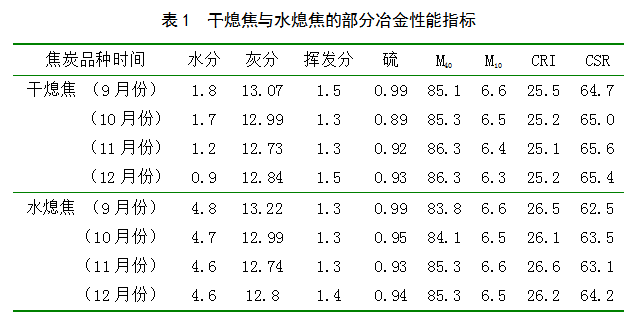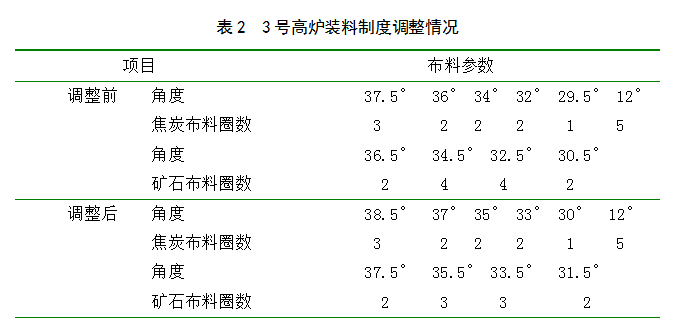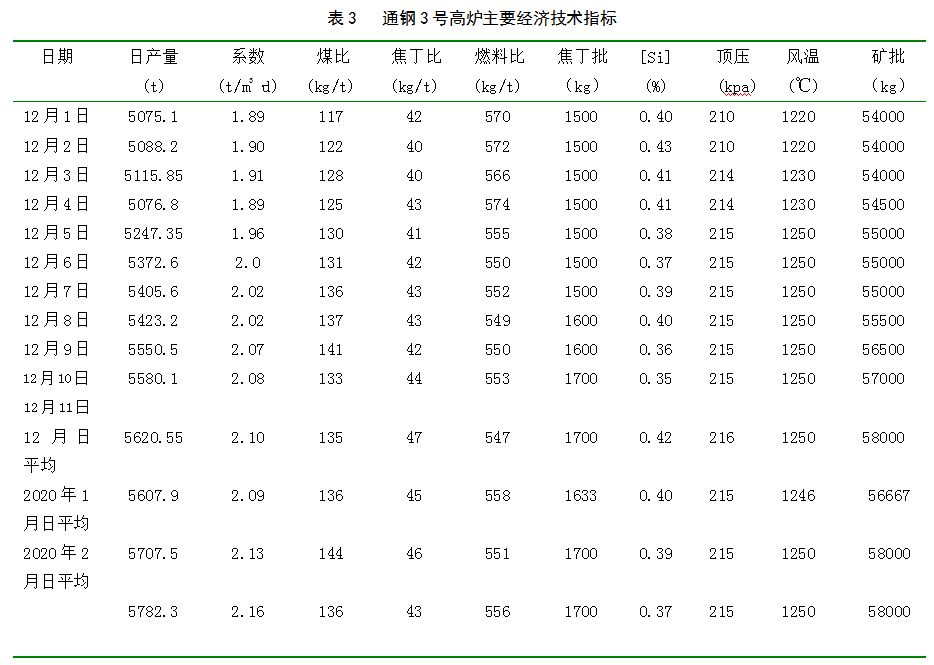15358968703

Production practice of activating hearth and increasing production capacity of No. 3 blast furnace of Shougang Tonggang
Abstract: This paper mainly summarizes the production practice of activating the hearth and improving the production capacity of Shougang Tonggang No. 3 blast furnace. In September 2019, the limited oxygen supply and the decline of pellet grade resulted in low blast furnace capacity. From October to November, affected by the increase of zinc load, the pressure difference in the furnace increased and the air volume decreased, resulting in the low blast kinetic energy and actual wind speed, which reduced the activity of the blast furnace hearth, and finally led to the fluctuation of the blast furnace condition, and the deterioration of the blast furnace production capacity and various economic indicators. By taking a series of measures such as improving the quality of raw materials and fuels, optimizing the operation system of the blast furnace, and reducing the load, the blast kinetic energy of No. 3 blast furnace reached more than 100kj/s, the wind speed reached more than 250m/s, the temperature at the bottom of the blast furnace rose, the working state of the hearth improved significantly, the blast furnace capacity increased, and the utilization coefficient of the blast furnace reached more than 2.0.
Key words: productivity practice of large blast furnace hearth
1. Overview
Tonggang No. 3 blast furnace was opened on July 12, 2014, with an effective volume of 2680m3 and a design capacity of 2.2 million tons / year. On February 28, 2019, the boiler was shut down for intermediate maintenance, which ended in 43 days. At 9:56 on April 13, the air supply ignition was started. The furnace condition has not been very stable since it was put into operation again. In May, the furnace condition of the blast furnace was abnormal due to the decline of coke quality; The furnace condition was restored and adjusted in June; 7. In August, it was overproduced. After September, the blast furnace capacity was low due to oxygen limitation and the decline of pellet grade; From October to November, due to the poor quality of raw fuels and the high zinc content in raw fuels, the zinc load in the blast furnace increased. The long-term enrichment of zinc in the blast furnace increased the pressure difference in the furnace, and the air volume shrank, resulting in the reduction of blast kinetic energy and actual wind speed. Affected by this, the activity of blast furnace hearth decreases, the central air flow is weak, the long-term air supply pressure is high, the pressure difference is high, and the air volume is difficult to increase. Such reciprocation further worsens the working state of the hearth. The hearth is the "engine" of blast furnace production and the basis of smooth operation of blast furnace ①. From late September 2019, a series of measures will be taken to activate the hearth, increase air volume and increase production capacity.
2. Performance and cause analysis of deterioration of hearth working condition
2.1 specific performance
1) Temperature of furnace bottom and core. The temperature of furnace bottom and furnace core is an important monitoring parameter for the working state of the hearth. The temperature of furnace core decreases significantly and lasts for a long time, which means that the working state of the hearth is getting worse and the hearth is not active. From August 2019, the temperature of furnace bottom and core decreased, and the temperature began to decline slowly. By the middle and late October, the decline was intensified, from the highest 593 ℃ to 494 ℃. The temperature drop of the bottom and core of the furnace increases and lasts for a long time, which indicates that the working state of the hearth is getting worse.
2) The relationship between the pressure in the furnace and the accepted air volume of the furnace. Due to the poor working condition of the hearth, the blast furnace is mainly manifested in the poor ability of the blast furnace to accept the air volume, the gradual shrinkage of the air volume, the poor stability of the air pressure, frequent spikes, the collapse of the material ruler, the reduction of the permeability index, the tension between the pressure in the furnace, and the increased difficulty of the blast furnace operation. Affected by this, the output of blast furnace began to decrease gradually.
3) Iron tapping in front of the furnace. Due to the poor working state of the hearth, the iron tapping state in front of the furnace becomes worse, and the maintenance of the iron mouth in front of the furnace is more difficult than before. The iron tapping time of the two iron tapping yards is uneven, the number of iron tapping increases, and the composition deviation of molten iron in the two iron tapping yards is large.
2.2 cause analysis of poor hearth condition
After September 2019, affected by various external market reasons, Tonggang was forced to purchase a batch of raw materials with high zinc content due to the deviation in the supply of raw fuels. In addition, the pellet grade of slate pellets decreased significantly, and the quality of coke declined. Restricted by the quality of raw fuel, the raw fuel powder entering the furnace increases, and the strength of sinter and coke decreases, resulting in the reduction of the permeability index of the blast furnace, resulting in the tension between the pressure of the blast furnace and the working state of the hearth.
3. Production practice of activating hearth and increasing production capacity
3.1 improve the quality of raw fuels
Raw materials refer to iron ore used in blast furnace ironmaking, including sinter, pellet and natural lump ore. The raw material structure of No. 3 blast furnace of Tonggang is: sinter + pellet (slate pellet) of No. 1 sintering machine of sintering plant of ironmaking division of Tonggang. Sinter accounts for about 80% of the ore in the furnace. Therefore, improving the quality of sinter is particularly important for the smooth operation of blast furnace, active hearth and improving production capacity. In addition, it is also important to improve the grade of slate ball. By adjusting the proportion and sintering speed of sinter, appropriately increase the thickness of the material layer and the appropriate moisture content of the mixture, try to mix the materials evenly through one mixing and two mixing, and control the ignition temperature and end temperature, so as to improve the stock conversion index of sinter and reduce the sinter powder. In addition, ensure the stability of pellet grade.
Fuel refers to coke and pulverized coal used in blast furnace ironmaking. The fuel structure of Tonggang No. 3 blast furnace is: coke produced by Tonggang coking plant (50% coke dry quenching + 50% coke water quenching). Coke is the framework of blast furnace charge column ②. In addition, coke provides most of the heat in the smelting process of blast furnace and is also a reducing agent. By adjusting the coal blending type of coke, reduce the coking speed, extend the coking time, reduce the reactivity index of coke, improve the post reaction strength of coke, and improve the quality of coke. See Table 1 for some metallurgical performance indexes of coke.

3.2 optimize blast furnace operation system
1) Thermal system: as the saying goes, "furnace temperature is the lifeline of blast furnace", so it is very important to control the furnace temperature in the smelting process. Stable furnace temperature is the basic condition for stable and smooth operation of blast furnace, and it is also a necessary condition for active hearth. Under normal furnace conditions, the furnace temperature (silicon content in molten iron) of No. 3 blast furnace is controlled at the level of 0.35% - 0.45%, and the physical heat of molten iron is above 1480 ℃. Low furnace temperature operation is strictly prohibited. After October 2019, in order to activate the hearth, the blast furnace operation area proposes to control the furnace temperature (silicon content in molten iron) at the level of 0.5% - 0.6%, and requires the physical heat of molten iron to be above 1500 ℃, so as to ensure that the hearth has enough heat, so as to improve the fluidity of molten slag and iron.
2) Slag making system: under normal furnace conditions, the slag of No. 3 blast furnace is required to be decorated with glass slag (that is, the section of the slag is hot glass with stone flowers). After October 2019, the operation area requires that the slag be hot glass slag, strictly prevent high alkalinity operation, and control the sulfur content in molten iron at the level of 0.04%-0.05% based on the principle of acid rather than alkali, so as to increase the circulation of the hearth and activate the hearth.
3) Charging system: the charging system is mainly to adjust the gas flow distribution in the upper part of the blast furnace. By adjusting the charging system, the gas flow distribution is reasonable and the blast furnace is stable and smooth. No. 3 blast furnace has always followed the idea of "opening the center and stabilizing the edge" in terms of air flow distribution. In view of this furnace condition, on the premise of opening the center, it is necessary to suppress the edge and ensure that the initial air flow can blow through the center. The impact of the air flow plays a decisive role in the replacement of the dead coke pile in the hearth. After the air flow blows through the center, the permeability and liquid permeability of the blast furnace are significantly improved, which increases the activity of the hearth. The No. 3 blast furnace operation area has made new adjustments to the charging system according to the furnace conditions: by taking the ore coke angle and gradually lifting out at the same time, the coke angle is adjusted from the initial 37.5 ° to the maximum 38.5 °; The angle of the ore is adjusted from the initial 36.5 ° to the maximum 37.5 ° (see Table 2); After the ore angle increases, the central funnel section can be appropriately expanded, so that the central air flow is not suppressed; After the angle of coke is increased, it can prevent the excessive edge suppression from leading to the bad furnace condition.

4) Air supply system: the air supply system refers to the selection of appropriate blowing parameters and air inlet state of the tuyere under certain smelting conditions to form a certain depth of the raceway, so as to achieve reasonable distribution of the original gas flow, uniform and active work around the hearth, and sufficient heat ②. The stability of air supply system is the premise of gas flow stability and an important condition to ensure the stability and high yield of blast furnace. The phenomenon of the furnace condition of No. 3 blast furnace this time is that the air volume is low and the area of the air supply tuyere is large, resulting in the low blast wind speed and blast kinetic energy of the blast furnace (the wind speed is 230m/s and the kinetic energy is 80-90kj/s). The long-term low wind speed and low blast kinetic energy gradually reduce the activity of the hearth. In view of this phenomenon, through the joint research of the ironmaking division and the Shougang expert team, it was decided to stop the wind and block four tuyeres and reduce the area of the air supply tuyere, so as to improve the blast speed and blast kinetic energy, so as to blow through the center and activate the hearth. Thus, the air supply system is stabilized. When the blast speed reaches more than 250 m / s, the blast kinetic energy is gradually opened on the basis of 100kj / s.
3.3 "attack, defend and retreat" measures shall be taken for blast furnace operation
During normal furnace conditions, the ore batch into the furnace weighs 55t/ batch, the coke batch weighs 12.5t/ batch, and the coke load is 4.4. In order to timely and quickly adjust the furnace conditions, the leaders of the division and the Shougang expert group held a meeting to study and decide to reduce the load step by step, so that the light load material can exchange for air volume. For the first time, the ore weight retreated to 47t/ batch, the coke batch did not move, and the coke load was reduced to 3.76. After 5 days of operation, the furnace condition did not improve, and there was no sign of increase in air volume, so the second ore weight retreated to 43t/ batch, the coke batch was reduced to 11.7t/ batch, and the coke load was reduced to 3.68. After the second unloading, the air volume increased, but it was not very significant.
In addition to the measures of "attack, defense and retreat", the blast furnace operation has also formulated strict operation guidelines, requiring the four shifts to unify the operation ideas and strictly implement the principle of low pressure difference, so as to prevent the fluctuation of furnace conditions caused by human factors, which will have an adverse impact on the recovery of the blast furnace.
3.4 stable equipment operation protects the blast furnace
Equipment guarantee is the key to the efficient and stable operation of blast furnace. For this purpose, the blast furnace operation area has formulated a series of equipment spot inspection systems, which are divided into professional spot inspection and non professional spot inspection. Professional spot inspection refers to the comprehensive professional inspection of equipment operation by maintenance personnel once a week; Non professional routine inspection refers to the equipment routine inspection of post personnel. We should do "regular spot inspection" and "early detection" to eliminate the accident in the bud and provide good equipment guarantee for the efficient and stable operation of the blast furnace.
4. Effect
Through the comprehensive application of the above measures, the hearth working condition of Shougang Tonggang No. 3 blast furnace has improved significantly, and the blast furnace capacity has been gradually improved. From December 1st, 2019, the temperature in the center of the furnace bottom began to rise. At the same time, the blast wind speed has reached more than 250m/s, and the blast kinetic energy has reached more than 100kj / s. on December 6th, 2019, the blast furnace capacity has exceeded 5350 tons, and the blast furnace utilization factor has reached more than 2.0. The main economic and technical indexes of blast furnace have made great progress. (see Table 3)

5. Conclusion
1) The hearth is the "engine" of blast furnace production and the basis of smooth operation of blast furnace. Only when the hearth is active can the blast furnace productivity be improved and various economic and technical indicators be optimized.
2) The blast furnace operation should not blindly pursue the area of the gale, but should select the appropriate air inlet area according to the actual raw material and fuel conditions, and must ensure that the blast furnace has sufficient wind speed and kinetic energy, so as to make the hearth active.
3) The furnace condition adjustment should be "stable, accurate and ruthless". The deficiency of this furnace condition adjustment is that the blast furnace load reduction is not in place, and there is a fluke in the operation.